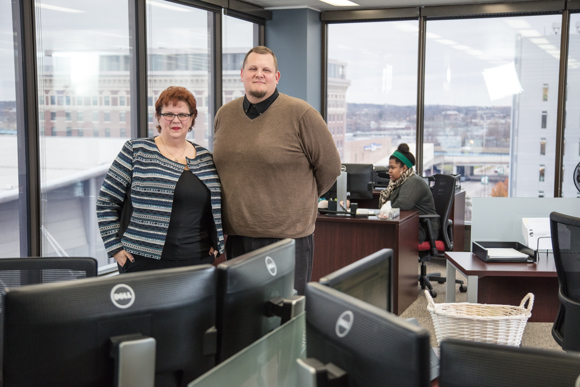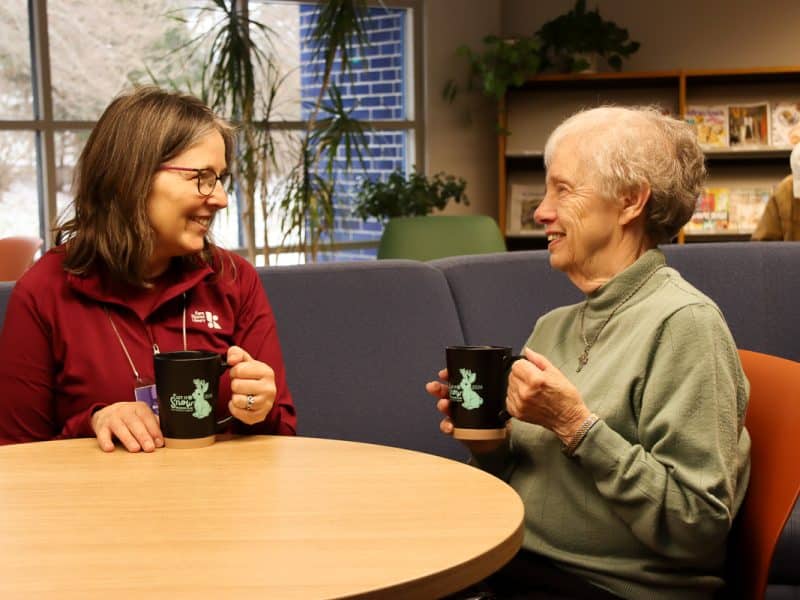The data driving Grand Rapids: How the city’s 311 program is reshaping where we live
As the leaders behind Grand Rapids' 311 system change and adapt the way we report everything from potholes to questions about voter registration, the data coming from the nationally recognized program is vastly improving the way residents interact with their government.

A beep on the line lets Mark Ritzema know the caller on the other end can hear him. Incoming charts and lines of data on a pair of monitors in front of Ritzema provide context to the situation.
The man is calling about a hole in the street. One sizable enough, and apparently intentionally cut out, to cause significant damage to a front rim. It’s not surrounded by orange cones, but he contends it should be, and the city needs to answer for it.
From the fifth floor of Grand Rapids’ City Hall, Ritzema has the man’s name, address and the history of his past calls on a set of monitors in front of him. A few clicks more and applications like Microsoft Dynamics’ customer relationship management platform, Cityworks for public works data, and Google Maps show Ritzema what sort of road work is being done and where. He tracks road closures around the area, and cross-references that with a list of engineering projects and sewer line work being performed in the city.
Ritzema is supervisor of the GR311 call center, the central nerve of the city’s customer service department. Launched in 2013, the city-run GR311 system is essentially a massive customer service operation that allows residents to call one hotline to connect with non-emergency city services and programs. By dialing 3-1-1, individuals can access nearly any city service, from recycling and voter registration to property tax information and electrical inspections. As part of the GR311 program, Grand Rapidians can also file complaints about everything from street light outages to graffiti that’s not being cleaned up.

On the call center floor, Ritzema and more than a dozen other agents are taking similar calls, each accessing the same service and account data to help provide the best solution. They’ve all been through the same intensive eight-week training program, and know how to respond to any call that comes in. It’s a team effort to get through a day successfully, and that means connecting with a lot of local residents.
On most days, an agent will log around 110 interactions, including phone calls, emails and walk-ins. After holidays, that number can spike to over 140, as residents have had an extra day to notice issues or wonder about municipal services like parking and trash pick-up schedules. An average call takes just under three minutes, and of all the calls that come in to the call center, less than seven percent are transferred to another department.
That’s a lot of responsibility for one department, which is why GR311 is protected behind one of the only locked doors inside 300 Monroe Avenue.

On this particular day, 309 calls have come in during the first two hours of business, with water account balances and yard waste disposal topping the list of inquiries. However mundane this may seem to the average resident of one of Grand Rapids’ 32 neighborhoods, the technology at work, and the intentional design behind it, are of national renown.
West Michigan may be far from Silicon Valley or Mountain View, but the region is replete with its own tech startups, leaders in digital development and other dynamic forces of progress. But even all the fruitful ideation of the private sector is eclipsed by the boundlessly interconnected solution systems soon being rolled out by GR311’s program director, Becky Jo Glover.
Glover has been running GR311 since it was launched three years ago. Having previously directed the Miami-Dade 311 call center in Florida for 14 years, she came to Grand Rapids with the intention of building a more efficient, more expedient system from the ground up with tested experience and techniques. And given the reach of our city’s call center at the time, that was a welcome goal to set.
Going mobile
Previous incarnations of a GR311 mobile app offered limited usefulness, with four choices for data reporting, one of them being “other” and attracting 60 percent of all input. Within six months, that app will be replaced with a new system that funnels resident reports into 28 different categories.
“We’re replacing that app with the highest technology that we have in the city,” Glover says.
Glover has the full support of the other city departments in deploying this new mobile app, which is based on call center technology currently used in 200 other cities in the United States. By connecting the dots through predictive models, GR311 now knows what people mean by “other'” and what they want to report online.
Data points between departments are linked through the Accela Civic Platform, which provides the framework and customer interface on the GR311 website and app, and Cityworks,the city’s asset management and tracking software, so agents like Ritzema can deliver the solutions residents need. Meanwhile, smart device location services embed the reports with GPS coordinates, which translate to specific blocks and addresses on the city’s end.
“When it comes through, it’s validated on the parcel, where before they might come in two parcels down,” Glover says. “It’s the technology we have now, and only requires a very small amount of data leveraging.”
And even when the solutions aren’t readily available, auto escalation lends residents the satisfaction of knowing their concerns are being bumped up to the next tier of urgency. The longer an inquiry about a water issue goes without closure, the more likely it is to find its way to the city’s Water System Manager, Joellen Thompson, for example. Those escalated and transferred calls currently amount to less than a thirteenth of the incoming calls to the center, and that fraction is yet shrinking. Glover says GR311’s solution system is a boon to department heads like Thompson, who can concentrate on civic solutions with fewer and fewer calls coming in.
It’s all part of a client-focused system, putting the immediate needs of the user first. Building on this design, a feedback loop between the city and its citizens will help speed the improvements with each iteration. The first roll out could go live as soon as February, Glover says.
“Before we launch it, we’re going to test it,” she affirms. “The one thing we as a city have noticed throughout this whole process at 311 is, the more you listen to your customers, you have them test what you’re doing, they have the best feedback.”
Dashboard lights
Concerned residents, city administrators, law enforcement officials, business leaders, and others each express different interests when it comes to getting the most out of public data, paying bills, and otherwise interacting with the city online. There are a lot of different viewpoints to consider, and with the help of Microsoft’s Power BI data visualization software, each one can be presented in a cohesive and compelling format.
Beginning with a bubble chart view of the city’s wards, Glover, and indeed anyone who uses the software, can analyze the types of calls coming in at each level, all the way down to individual neighborhoods. If water issues are being reported in one specific area more than others, those searching for predictive trends may prompt problem solving measures to be taken. If a segment of the city is continually paying bills in person because the app or website is too confusing, that insight can be gleaned as well.
The city’s new “digital first” website, a $625,000 update of grcity.us, will combine ease of use with ubiquitous access across smart devices and computers. Residents will be able to call up and analyze the same data once the first segments are released in 2017. It also heralds a new direction for Grand Rapids’ online presence, positioning itself as a resource as well as a partner with civic-based organizations like Downtown Grand Rapids Inc. (DGRI) and Experience GR.

These local partners will be able to take advantage of the new site’s utility in more ways than one. DGRI Director Kris Larson says his technological affinities are consistent with “most Gen Xers – traditional ties to email and other work software, plus being chained to my iPhone.” He’s also interested in the digital applications that somehow ease pressure points along the way, and “simplify the citizen experience.”
Car sharing apps, bus route mapping systems that minimize wait times, and other integrated products help people get more out of and into each day, Larson says. Soon, the city’s website will be doing the same, along with providing a platform to display opportunities and resources from organizations like DGRI, as well. Events calendars, work opportunities, and other services that residents can benefit might all some day soon be accessible through the GR311 site.
It’s also going to be easier to use.
Not long ago, the homeowners of Grand Rapids once were responsible for remitting the obscurely named, multi-paged, “Water Utility Agreement.” Glover says it took a stance in front of the City Commission to bring inefficiencies like this to light, but she’s succeeded in doing so. The form, which essentially tells the city to turn your water on, was first trimmed down to three pages before Glover had wherewithal to simplify it further. It’s now a breezy, single-sided document, which is easily translated to a group of fields to fill out online.
There are countless ways of organizing the data and helping people interact with the city’s digital presence in meaningful ways. And they’re all the advanced cumulation of research and development Glover has personally been a part of since she began building the Miami-Dade call center in 2002.
Glover’s journey
Fourteen years ago, it was nearly impossible to visualize the importance or utility of the same data when the means to display and analyze it hardly existed outside of tremendously advanced facilities.
“You don’t know what you don’t know,” Glover says. “I built the [Miami-Dade] center to the best of my capabilities, and I had never built a call center. I was in Coke plants for years. You learn a lot of lessons when you’re there, though, and might say ‘I wish I would have done that.’”
Whatever challenges Miami-Dade’s call center may have come across, Glover’s system began to overcome these issues with ease. By teaching the agents how to use effective scripts based on issue categorization–a role she admits she initially had no interest in–and connecting data points within the city, she opened up a new era of effectiveness for the department that still leads the country in innovation.
Of course, call center mastery hasn’t always been on Glover’s list. After graduating from Texas Lutheran University, the Lone Star State native headed to Florida. There, she spent four years as director of training and concessions for the Miami Seaquarium, followed by almost seven as a quality assurance technician for Coca Cola before joining the Miami-Dade County government. Specializing in community information and outreach, Glover played a key role in the call center’s growth between 1998 and 2013. And when the opportunity arose to move to Grand Rapids and build a brand new center from the ground up, she was eager to get started, all over again.
Beginning with some of the same scripting strategies she employed at Miami-Dade, Glover designed communication guides for the different issues Grand Rapidians are concerned with. The technology followed quickly behind.
“The city knew what they wanted, but I knew that one day the city would want to see everything at the neighborhood level,” Glover says. “There’s a story at the neighborhood level, and you want to coordinate that data with census data, with data for the weather, anything you can bring it out.”
Defining those stories through note taking in the online applications helps Glover, Ritzema and the other call center agents predict when issues may arise, and focus services on the needs of the client. It’s a means of showing respect by giving people the information they need, Glover says.
Glover has spent 21 years working in government, and she says she’s noticed more so in this career than any other that it’s important to listen to clients, instead of telling them what they want. It helps build better government, and better government websites.
“We’re trying to get to a point where everything we do is based on feedback, user testing, and user-centric design,” she says. “And that means updates. If it’s an abandoned vehicle, is it tagged? Has it been towed? When was it towed? We also want to see what’s going on in the neighborhoods in a very easy way.”
City of tomorrow
As game-changing as the GR311 call center is, it’s thanks to the cooperation of other city departments, and other local organizations, that makes it even more effective.
Now finding ways to deliver on emerging civic-minded opportunities at DGRI, Kris Larson came to Grand Rapids in 2012, taking over the organization’s executive directorship from Jay Fowler. The Raleigh, North Carolina native claims he’s got “the best job in GR,” and while it’s not without its challenges, Larson says DGRI is able to embrace innovation wherever feasible to help improve our understanding of the city.

“From installing pedestrian counters to measure utilization of the public realm to building a proprietary web CRM that aggregates social media feeds from downtown establishments – we are always looking for innovations that will enable us to do better by our community,” he says.
Like Glover, Larson is also a transplant to the community, hailing from Raleigh, N.C. His roots in city building initiatives run deep, as well. After obtaining a master’s in public administration and an AICP credential from the American Planning Association, spent 12 years in different urban environments, honing his acumen for place management. His first major appointment was as deputy director of the Downtown Raleigh Alliance in Raleigh. And he was later named vice president of the Downtown Long Beach Association in Long Beach, Calif. Before coming to West Michigan.
In his four years at DGRI, Larson has implemented such client-focused projects as the Ambassador program, a team of capable guides who assist Grand Rapids’ residents and visitors throughout the year. GR Ambassadors are trained to immediately refer 311-related reporting items into the 311 system, Larson says, and make the most of their connected technologies.
“With the Ambassador program in particular, we recently upgraded our team’s handhelds to geolocate every interaction or service we provide,” Larson says. “This also allows us to take an analytical approach to understanding simple trends – such as instances of graffiti – to other items that can influence infrastructure planning, such as bicycles being inappropriately locked to street trees. These observations, aggregated over time, can help us learn where to deploy more bicycle racks to meet the need of our bicycling citizens.”
The not-so-distant future will see even more public-private partnerships from the likes of the city and DGRI, as well. As Govtech.com recently reported, tech startup HAAS Alert has been working with Grand Rapids on vehicle-to-vehicle communication systems that will inform drivers and respond to on-duty emergency vehicles in real time.
Beyond that, the expansion of 311 will be a key element in the city’s plan for success in the coming years, as will new technologies we may have yet not even begun to explore.
Back at the call center, Ritsema has made a note of the large pothole in several different applications, alerted public works to the problem and assured the caller a solution will be delivered shortly.
A brief silence, and there’s another beep on the line. This time, a resident calling about trash pickup.
The city bins are equipped with RFID tags, which allow drivers to locate them and plan routes, and Ritzema to monitor when they’ve been emptied. This particular street hasn’t been visited yet, but there are a few hours left in the day. That answer will suffice for the caller.
“Glad to be of service,” Ritzema says.
This is the third article in a 12-part series highlighting the technological innovators and drivers in West Michigan. To see previous articles in this series, please go here. With this series, Rapid Growth will delve into the question: What are businesses and organizations doing to leverage technological advances to create an impact within our region, and what are the stories behind these agents of sweeping change in our society? This series is funded by Open Systems Technologies(OST), a Grand Rapids-based information technology leader that is delivering enterprise level solutions around the globe.
Matthew Russell, the editor of this series, is a writer, baker, inventor and mapmaker living in Grand Rapids. He enjoys bicycling and playing with his daughter as much as possible. You can email him at m.s.russell@gmail.com, or follow him on Facebook and Twitter.
Photography by Adam Bird.









